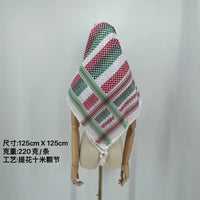The Keffiyeh: A Symbol of Palestinian Identity with Roots in the East
The keffiyeh, a distinctive black-and-white chequered cloth, holds a special place in the hearts of many Palestinians. For some, it's even considered the unofficial flag of their nation. This simple square-meter fabric, traditionally folded diagonally into a triangle and draped over the heads of rural Palestinian men, has become a powerful symbol of the Palestinian cause.
Today, the keffiyeh is not just worn by Palestinians but also by human rights activists, anti-war protesters, sports stars, and celebrities from around the world. It transcends gender, religion, and nationality, serving as a unifying symbol of solidarity with the Palestinian struggle.
For Muhammad Walid, a 49-year-old from Jerusalem, the keffiyeh is a cherished part of his heritage. "I remember seeing my father and uncles wear it when I was very young," he recalls. "The older generations wore it on their heads, but I started wearing it as a teenager, around my neck. For me, it represents the Palestinian struggle and cause."
Riad Halak, a 62-year-old also from Jerusalem, shares a similar sentiment. "It's a tradition of Palestine," he says. "I started wearing one when I was 11 years old, and I still wear it today on special days like the Nakba. It's part of my identity."
While the keffiyeh's status as an icon of Palestinian nationhood is well-established, its origins actually lie further east, in what is now Iraq. The word itself means "relating to Kufa," a city south of Baghdad along the Euphrates river. However, little else is known about the keffiyeh's roots.

One account suggests that it originated in the seventh century during a battle between Arab and Persian forces near Kufa. The Arabs were said to have used cords made from camel hair to secure their headdresses, allowing them to recognize their comrades in the heat of battle. After their victory, they kept the headgear on as a reminder of their triumph.
Others believe that the fabric, sometimes called the hata in the Levant, has origins that pre-date Islam and can be traced back to Mesopotamia. It was worn by Sumerian and Babylonian priests around 5,000 years ago.
Anu Lingala, author of "A Socio-political History of the Keffiyeh," notes that "its origins are open to speculation. Until very recently, these types of designed objects were not taken seriously as subjects of academic research. The exception was for designed objects that were associated with elite status and wealth, whereas the keffiyeh was traditionally associated with working classes."
Despite the uncertainty surrounding its origins, the keffiyeh remains a powerful symbol of Palestinian identity and a reminder of the ongoing struggle for justice and freedom.






